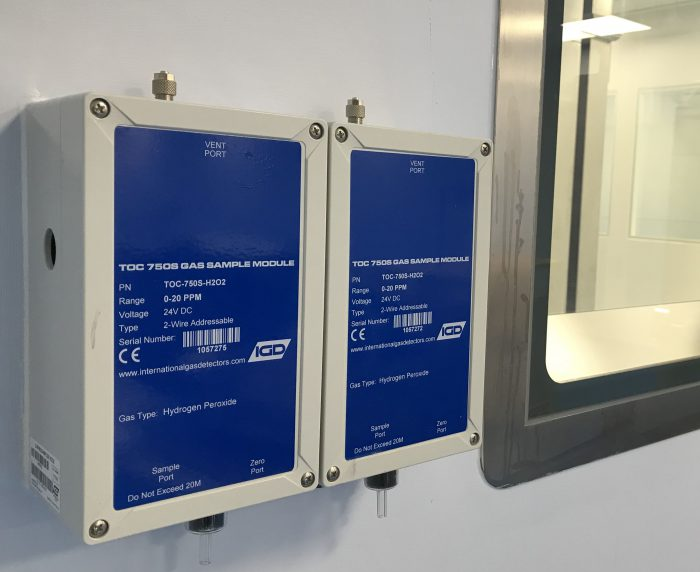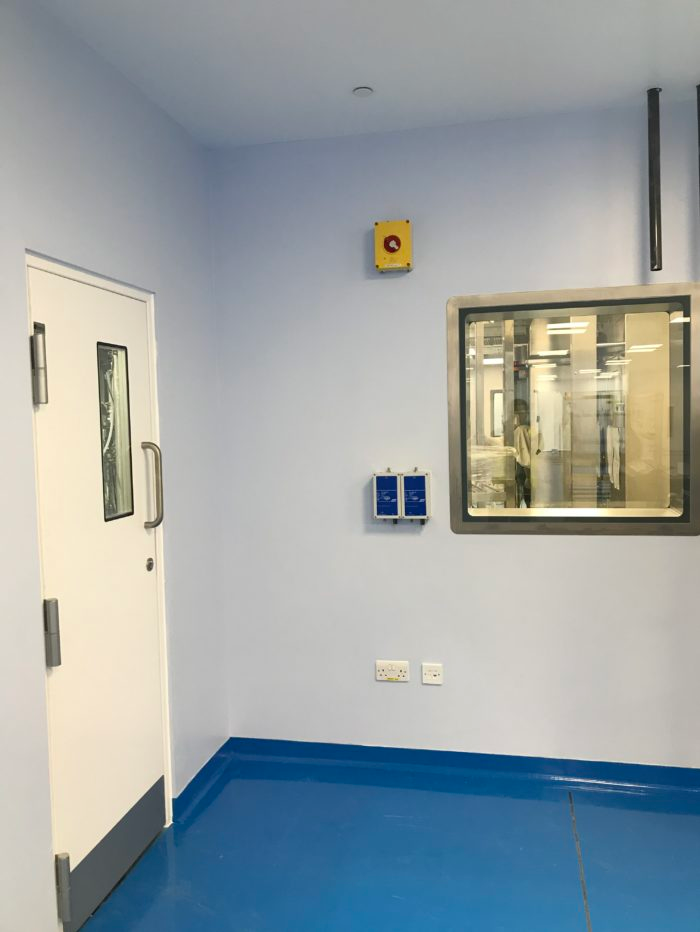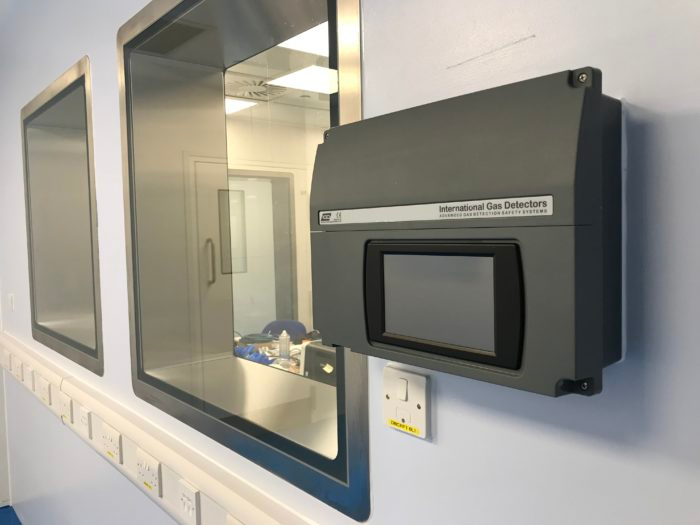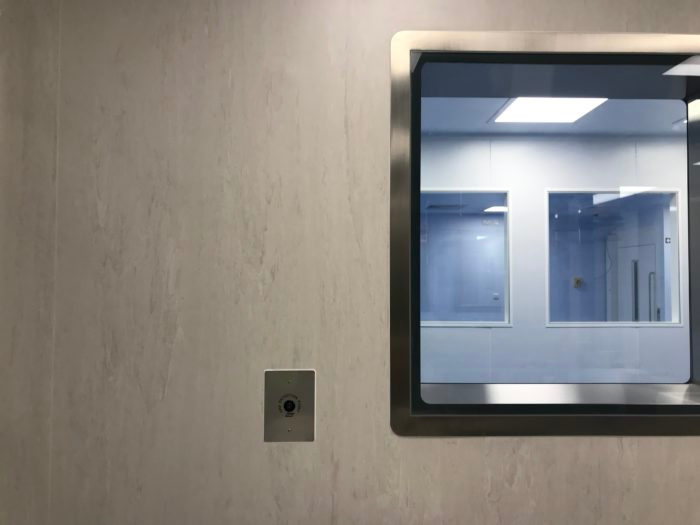Teva Pharmaceutical Industries Ltd is a market leader in the manufacturing of generic medicines, operating the largest network of fully integrated manufacturing and delivery systems within the pharmaceutical industry.
This network is world-leading and creates over one billion of the world’s doses of sterile injectable drugs per year.1 IGD was tasked with providing a hydrogen peroxide (H2O2) detection system that would be suitable for use in Teva’s aseptic cleanroom. This article examines the vital aspects to consider when undertaking the process of gas detection equipment in a cleanroom environment, and methods by which to overcome such challenges using sampling gas detectors.
Within the pharmaceutical industry, cleanrooms are in common use. In this industry, cleanrooms are used to offer an environment that is contamination-free and therefore appropriate for the manufacture of sterile medical products and pharmaceuticals. The goal is the same as with all cleanrooms; to remove airborne particles and thus prevent them from contaminating the manufacturing process, as well as eliminating microorganisms, which is of particular and paramount importance in this industry.
A cleanroom environment is vital for Teva’s production of glass vials of medication. The presence of a single microorganism during the manufacturing process could have truly catastrophic consequences. – so it is essential to guarantee and maintain a safe and sterile cleanroom environment for the unencumbered production of glass vials. The system is sterilized with hydrogen peroxide and purged in order to remove the risk of microbial contamination.
At low concentrations, hydrogen peroxide is nonirritating, as well as being odorless. If it is inhaled, however, hydrogen peroxide presents a serious risk to health and damage to the respiratory system - in enclosed environments like cleanrooms, it even poses an asphyxiation hazard.2,3 In order to maintain safety for those working within these sites, Teva must ensure that levels of hydrogen peroxide within the environment can be both monitored and controlled to be kept within limits after sterilizing occurs.

TOC-750-H2O2 hydrogen peroxide sampling gas detectors installed at TEVA.
The Complexities of Detecting Gas in a Cleanroom Environment
Using the most appropriate sensor technology is vital when overcoming the challenge of detecting H2O2. Teva’s highly-controlled and monitored cleanroom environment means that such a gas detection solution is not a straightforward one, and as such is vital to consider all elements when finding a solution for such issues.
In this case, cleanliness was the most important consideration. Maintaining cleanroom standards of cleanliness and procedures of cleaning whilst introducing additional equipment is crucial, as pharmaceutical cleanrooms are meticulously designed for their purpose.4 Within a cleanroom, any surface presents a possible site where airborne particles can accumulate, so naturally, a gas detector which is wall-mounted as standard can be potential dirt-trap or bug-trap, which are both unacceptable within a cleanroom.5 This means that the gas detection solution needed in this environment must be easily cleanable, with as small a surface area as can be found.
There is a further factor impacting the requisite size of the chosen solution: the price of cleanrooms, and the value of the space inside them. It is therefore imperative that the chosen solution has as small a footprint as possible.
A further requirement is that the gas detection system must be easily maintainable. In order to maintain equipment within a cleanroom, the servicing engineer must adhere to cleanroom protocol, which includes the decontamination of tools and equipment in advance as well as wearing the appropriate apparel. These measures can, of course, be particularly time-consuming, increasing the inconvenience and price which are associated with equipment servicing and maintenance. Teva, therefore, requires a solution in which the gas detectors could be easily serviced externally to the cleanroom.
Sampling Gas Detectors for Controlled Environments
Teva’s 750 series sampling gas detector is truly ideal for such environments. In order to sample or aspirate a gas detector, the user must draw a gas sample from the desired detection point to a remotely located detector.6 In addition, the particularly small size and surface area of the samples help to minimize the risk of them becoming a bug-trap or dirt-trap whilst locating the detector units outside the cleanroom, guarantees that they are easily serviced with minimal disruption to existing cleanroom procedures. In addition, the team, in this case, took special care to ensure that the sample tube routes and highway cable routes were kept accessible for easy maintenance.

IGD 750 Samplers outside the TEVA Clean Rooms. This provided easy access to maintain and service the sensors.
Once the system was designed, Teva installed 5 x TOC-750S-H2O2 sampling detectors, which used valve-free piezo pump technology to guarantee low maintenance requirements as well as reliable performance. A single TOC-750-150 control panel controlled the five samplers, and a visual/audible alarm system and a room status indicator were installed to ensure the safety of all personnel using the cleanroom.7

IGD TOCSIN 750 Control Panel with 7″ Colour HMI display. Outside of the TEVA Clean Rooms.
End of Line Options – Sampling Gas Detectors
In addition, the TOC-750S-H2O2’s stainless-steel plates assisted to further flush mount the Luer Lock through the wall sample points. These plates are naturally designed to penetrate cleanroom cavity walls as well as boasting the smallest possible footprint in order to reduce the risk of becoming a ‘dirt-trap’ or a ‘bug trap’ on the cleanroom side of the wall.

End of Line Luer Lock through wall sample points. Providing a small footprint and non-bug trap sample point for inside the cleanroom.
A high -performance gas detection system was designed for Teva thanks to their years of experience as world-leaders in gas detection technology. All new target gas types are tested in a dedicated laboratory located at the head office, despite never developing a detection system for H2O2 before. This testing ensures that all the sensors meet high standards for performance and accuracy. Teva can create, consult on, and install gas detection systems that can test for all exotic gases to an extremely high degree of accuracy, with the best sensor technology on the market today.
References and Further Reading
- Teva’s Global Supply Chain | Teva Pharmaceuticals. Available at: https://www.tevapharm.com/our-company/supply-chain/. (Accessed: 28th March 2020)
- ATSDR – Medical Management Guidelines (MMGs): Hydrogen Peroxide. Available at: https://www.atsdr.cdc.gov/MMG/MMG.asp?id=304&tid=55. (Accessed: 28th March 2020)
- Watt, B. E., Proudfoot, A. T. & Vale, J. A. Hydrogen peroxide poisoning. Toxicological Reviews 23, 51–57 (2004).
- Basic clean room design requirements and considerations. Available at: https://www.pharmout.net/basic-cleanroom-requirements/. (Accessed: 28th March 2020)
- Whyte, W., Agricola, K. & Derks, M. Airborne particle deposition in cleanrooms: Calculation of product contamination and required cleanroom class. (2016).
- Do I Need a Sampling Gas Detector? – International Gas Detectors : International Gas Detectors. Available at: https://www.internationalgasdetectors.com/do-i-need-a-sampling-gas-detector/. (Accessed: 28th March 2020)
- TOCSIN 750 SERIES. Available at: https://www.internationalgasdetectors.com/wp-content/uploads/2017/07/Tocsin-750-Manual-V3.51.pdf (Accessed: 28th March 2020)

This information has been sourced, reviewed and adapted from materials provided by International Gas Detectors Ltd.
For more information on this source, please visit International Gas Detectors Ltd.